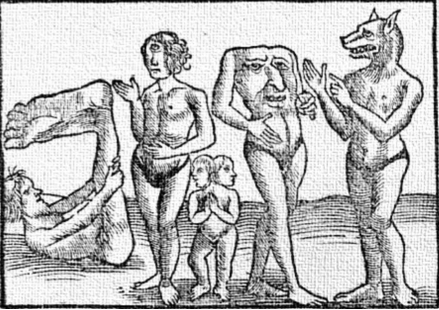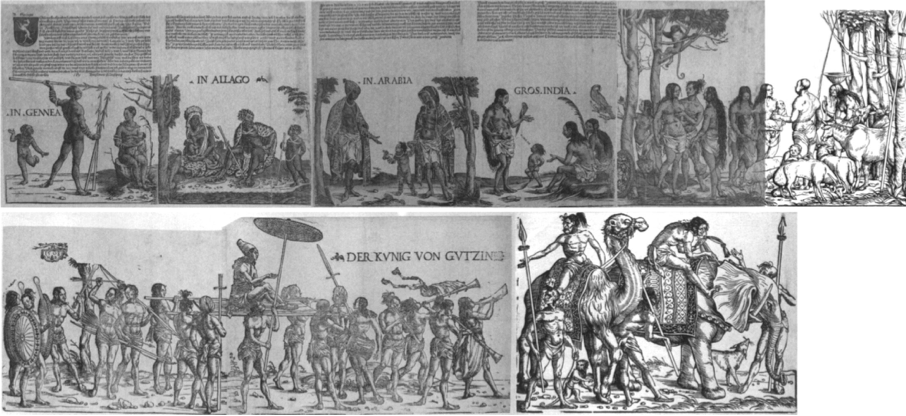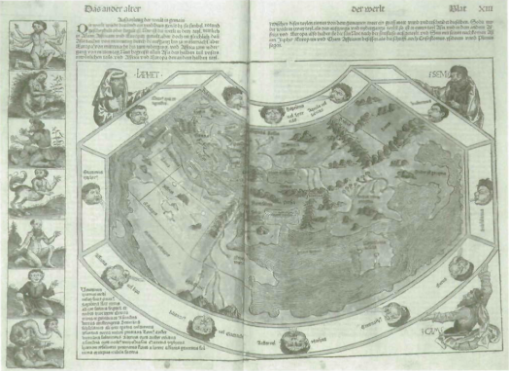Antoine Leveque
The current definition of the term “species” only started to emerge in Europe during the historical period that Western scholars call the Enlightenment. Before 1750, Christian theology asserted that God had created all species in an immutable fashion.[1] In pre-modern times, European learned discourses were dominated by the political perspectives of the Christian Church.[2] Species were therefore conceived as “essences” but, after World War II, when the genus homo started to be established from the standpoint of comparative anatomy in a non-racialist paradigm,[3] the term species then started to be simply understood as biological: a succession of individuals.[4] Before the Enlightenment, Western European scholars did not consider individual bodily differences as something important to their theological science. This is not to say that ancient Greco-Roman science or pre-Enlightenment science considered the body as unimportant. However, the body of non-Western Europeans was often imagined rather than studied anthropologically.
Figure 1. An image traditionally found in medieval books. This depiction of diversity is borrowed from the natural history of an authoritative Roman author named Gaius Plinius Secundus (CE 23–79), known as Pliny the Elder.’ This is a phantasmagorical rendering of far-away people before Western Europeans mastered oceangoing ships and gunpowder technology. (Image in the public domain.)
For instance, language and religious faith were more important to Western European scholars than traits such as skin color or hair type. The most important point is that Western European theologians considered the members of our species as beings possessed of an immortal soul. Following ancient theories such as that of Aristotle, they deemed this soul to be naturally rational. However, a conversion to Christianity though the religious rite of baptism was indispensable in order for people to be considered human beings.[5]
As the Christian Church became an epistemic and political institution from the 5th century CE onward, a specific doctrine about mankind crystallized in European learned discourses and scholarly circles. The Church’s theorists argued that the label homo (the Latin for “man”), which was used in pre-Christian science, was to be applied to any living form endowed with the ability to reason and the ability to speak.[6] If one could utter words, learn a language, and speak in an intelligible manner, Western European science considered that person possessed the character that was considered as the distinctive sign of species membership. However, before the introduction of transcontinental navigation technology, people living overseas and far away from Europe did not speak the same languages as the Europeans, who came to exploit natural resources, trade, colonize, and convert locals to Christianity.
The aggressive behavior of European merchants made cultural exchanges and good diplomatic relationships between people difficult. This was especially true where financial capitalization was the prime aim of the then emerging Western European nation states, which launched the overseas travel expeditions.
Figure 2. This 1493 wood engraving was printed after a powerful Augsburg merchant family launched the first commercial enterprise to continents far away from Western Europe. It depicts the people encountered by Europeans and relativizes the subjects to the European viewer by using iconographic models that were familiar in Europe. From Stephanie Leitch, “Burgkmair’s Peoples of Africa and India (1508) and the Origins of Ethnography in Print,” Art Bulletin 91, no. 2 (June 2009): 135, https://doi.org/10.1080/00043079.2009.10786162. (Image in the public domain.)
Because of their technological means and the nature of their purpose, Europeans rarely felt compelled to recognize the linguistic and rational abilities of the people they came into contact with.[7] Colonization was mostly conducted for financial profit and only missionaries were tasked with transforming and integrating conquered individuals into the mother countries. In time, and with the development of African-based slavery, the validity of the classical criteria for establishing species membership would itself be doubted: that is when the geographical concept of race started to be used in science. This development only happened from the late 17th century onward.[8] From then on, learned discourses would increasingly focus on the variability of physical characters peculiar to the different groups making up our species. However, this focus was virtually absent in Western European scholarship of the medieval and early modern period.
In the fifth and sixth centuries CE, the Catholic theologian Augustine of Hippo (354–430) had produced a synthesis conflating ancient Greco-Latin theories about our genus, on the one hand, and the revealed truths contained in the Bible, on the other. His discourse was used as a foundation for the Church’s doctrine, which relied on the book of Genesis to state that all the members of our kind were descendants of Adam and Eve, who are the male and female mythical figures contained in the Bible.[9] Theologians of the Catholic Church devised a strict criterion to distinguish between humans and nonhumans. Thus, their religious and political entity could grow maximally, up to the point of extending virtually to the confines of the habitable Earth.[10] Except for a few marginal authors, European scholars of the early modern period considered mankind to be one genus. Jesus of Nazareth had proscribed ethnic divisions in his teachings, which were relayed by his disciples in what Christians call the New Testament. This text was a central point of reference for the Church, both as a political institution and as an institution of knowledge. Individuals belonging to the category human possessed an ability to understand the intent of God, the supposed author of nature according to Christian theological science.[11] This criterion allowed Western Europeans to establish a distinction between mankind and the animal kingdom. However, it also required that people converted to the Christian faith. This ability was identified as an endowment specifically given by God to one species, which had been entrusted with a mission: that of accomplishing the Christian god’s will on Earth.
As Western European nation-states emerged in the late Middle Ages, scholars looked more freely toward natural science to theorize about the human soul and this altered the structure of theological discourses. The Protestant Reformation introduced an epistemic shift that allowed anatomical study to develop independently of the Church’s canonical and authoritative theologians.[12] All souls had equally been created by God according to pre-modern Western European science.[13] However, the body became a new topic of inquiry with the political rise of bourgeois identity. An important shift happened when astrology and other environmental and geographical influences started to become part of theology.[14] Alongside the holy Christian scripture, natural science now gave scholars a new perspective. They could produce theories about the human soul and how its faculties varied according to climate and other environmental influences, such as diet and intellectual or physical exercise.
When Europeans colonized the world from the 15th century onward, they generally justified their endeavor as being the Christian fulfilment of a divine mission. However, pre-Christian theories from antiquity also started to be incorporated into early modern learned discourses about the variety of customs, languages, and physical traits among the Earth’s people.[15] Since all humans descended from Adam and Eve according to the Christian doxa, it was difficult to explain how far-away regions that were not mentioned in the Bible had been peopled. The legal right and justification of conquest was at stake when those questions were debated among scholars.[16] However, the peculiar physical characteristics of the world’s different peoples was not something of importance in science during the early modern period.
Figure 3. Hans Pleydenwurff and Michael Wolgemut, “Map of the World, in Nuremberg Chronicle, 1493 (artwork in the public domain). A new strategy is at play here: pre-Christian phantasmagorical representations of diversity are on the left margin. The Earth is divided among Sem, Japhet and Cain, the three sons of Noah, the mythical figure who peopled the earth after a putative universal flood, according to the story told in the book of Genesis, which is contained in the Bible.
Before 1750, the taxonomy of people was based on religious faith, which accounted for the divide between political entities.[17] The essentialization of differences between people of European, Asian, and African descent originated more in folk knowledge than in scholarly discourses.[18] For science, all indigenous people could and should be transformed both physically and morally through missionary work. With few exceptions, Western European thinkers before 1750 held a conception of all people as fundamentally the same. When the pope mandated colonizing European monarchies to convert the recently discovered peoples of the world,[19] missionaries believed that all people were in possession of a savable soul.[20] This theory justified proselytism and conquest, but not segregation, as would be the case when the geographical concept of race spread in the language of science from the mid-eighteenth century onward.
[1]. Folk taxonomies and definitions of the species concept shall not concern us here. For this subject, see Scott Atran, “Origin of the Species and Genus Concepts: An Anthropological Perspective,” Journal of the History of Biology 20, no. 2 (Summer 1987): 195–279, http://www.jstor.org/stable/4331011; and Scott Atran, “The Early History of the Species Concept: An Anthropological Reading,” in Histoire du concept d’espèce dans les sciences de la vie(Paris: Singer-Polignac, 1987), 1–36.
[2]. When this term is capitalized, it refers to the political and epistemic Christian institution, not to the building.
[3]. B. A. Wood, “The History of the Genus Homo,” Human Evolution 15, nos. 1–2 (2000): 39–49, https://doi.org/10.1007/BF02436233.
[4]. Ernst Mayr, The Growth of Biological Thought (Harvard: Harvard University Press, 1982), p. 261.
[5]. Anthony Pagden, The Fall of Natural Man: The American Indian and the Origins of Comparative Ethnology (Cambridge: Cambridge University Press, 1986), 103.
[6]. Some contemporary theorists of feminism have argued that pre-modern learned discourses linked the sexual diversity of body between men and women to a natural difference in intellectual ability. Furthermore, they have argued that this type of learned discrimination among genders formed the theoretical matrix on which scientific racism was built after 1750. See Elsa Dorlin, La matrice de la race: généalogie sexuelle et coloniale de la nation française (Paris : La Découverte, 2014). If they are correct, then the Latin ”homo” did not refer to man and woman, but only to men. See also Londa Schiebinger, Nature’s Body: Gender in the Making of Modern Science (Boston: Beacon Press, 1993).
[7]. The technological superiority of Europeans consisted, for instance, of the oceangoing ship and the canon. James E. McClellan III and Harold Dorn, Science and Technology in World History: An Introduction, 3rd ed. (Baltimore: John Hopkins University Press, 2015), 220.
[8]. The concept of race came from the vocabulary of animal and plant breeders. It was used for the first time to speak about the human species to refer to the royal dynasties of French kings. The French nobility then used it from the sixteenth and seventeenth century onward to secure their political privileges over the common people, after gunpowder had changed the feudal political system and large monarchies started to centralize political power. See Pierre H. Boulle, “Francois Bernier and the Origins of the Modern Concept of Race,” in The Color of Liberty, Histories of Race in France, ed. Sue Peabody and Tyler Stovall, 2nd printing (Durham, NC: Duke University Press, 2006), 11–27, 20.
[9]. David N. Livingstone, Adam’s Ancestors: Race, Religion, and the Politics of Human Origins (Baltimore: John Hopkins University Press, 2008).
[10]. The etymological root for the term “catholic” is the ancient Greek term katholikos, which means “universal.” However, this term was only used early in the history of the Church, before it became popular again after the Protestant Reformation of Martin Luther and John Calvin. Augustine of Hippo used it to refer to those Christians who had the “true faith” and who complied with the Church’s political and spiritual ambitions.
[11]. John Block Friedman, The Monstrous Races in Medieval Art and Thought (Syracuse: Syracuse University Press, 2000).
[12]. The structure of medieval knowledge was based on the study of a given number of texts. European scholars were trained through the learning and discussion of those texts, which were called auctoritates. See Steven J. Livesey, “Scholasticism,” in Medieval Science, Technology, and Medicine: An Encyclopedia, ed. Thomas Glick, Steven J. Livesey, and Faith Wallis (New York: Routledge, 2005), 453–55.
[13]. For Augustine and all major official Catholic discourses up until the 13th century, all human souls were fundamentally and essentially equal. The relationship between the three faculties of the soul— memory, intellect, and will—were then understood according to the relationship between the elements of the Holy Trinity. “Haec tria, une vita, una mens, una essentia.” See Augustine, lib. 10, cap. 11), in W. J. Mountain, ed. De Trinitate, Corpus Christianorum series latina, vol. 50 and 50a (Turnhout, Belgium: Brepols, 1968).
[14]. Edward Grand, Studies in Medieval Science and Natural Philosophy, chap. 13 (London: Variorum, 1981), 211–44; Clarence J. Glacken, Nature and Culture in Western Thought from Ancient Times to the End of the Eighteenth Century (Berkeley: University of California Press, 1967); and Marian J. Tooley, “Bodin and the Medieval Theory of Climate,” Speculum 28, no. 1 (January 1953): 64–83.
[15]. In the early sixteenth century, right after the start of the Spanish and Portuguese colonization of the Americas, new scholarly texts emerged among the auctoritates. For instance, a new passage by Aristotle on “natural slavery” entered the corpus of authoritative of texts in 1519. Hugh Thomas, Rivers of Gold: The Rise of the Spanish Empire, from Columbus to Magellan (New York: Random House, 2005), 297-98. Anthony Pagden, The Fall of Natural Man; and Lewis Hanke, Aristotle and the American Indians: A Study of Race Prejudice in the Modern World (London: Hollis and Carter, 1959).
[16]. For instance, scholars belonging to particular European monarchies would sometimes not hesitate to claim that the people they wanted to colonize overseas were remote descendants of their own nation. See M. L. Kuntz, Guillaume Postel: Prophet of the Restitution of All Things. His Life and Thought (The Hague: Kluwer, Martinus Nijhoff, 1981); Toy-Fung Tun, “Of Adam’s Rib. Cannibalism and the Construction of Otherness through Natural Law,” in Theorizing Legal Personhood in Late Medieval England, ed. Andreea D. Boboc (Leiden: Brill, 2015), 218–43; and Giuliano Gliozzi, Adam et le Nouveau Monde. La naissance de l’anthropologie comme idéologie coloniale: des généalogies bibliques aux théories raciales (1500–1700) (Nîmes: Théétète éditions, 2000).
[17]. Ivan Hannaford, Race: The History of an Idea in the West (Baltimore: John Hopkins University Press, 1996); 148–49.
[18]. Lay and unofficial interpretations of the biblical story about Noah’s three sons were produced during the Middle Ages about the peopling of the world and the diversity of customs and physical traits among the world’s peoples. See Benjamin Braude, “The Sons of Noah and the Construction of Ethnic and Geographical Identities in the Medieval and Early Modern Periods,” William and Mary Quarterly 54, no. 1, Constructing Race (January, 1997): 103–42.
[19]. In this regard, two events are worth mentioning. First, the Treaty of Tordesillas, which was signed between the pope, the king of Spain, and the king of Portugal, on June 7, 1494. Under the pope’s benediction, it divided the newly discovered world between Spain and Portugal, under the expression condition that the newly conquered people would be Christianized. The second event was the Valladolid controversy, at the end of which the Church decided that Amerindians were creatures naturally endowed with the ability to understand the plan of the Christian god. See Stephanie B. Martens, The Americas in Early Modern Political Theory States of Nature and Aboriginality (New York: Palgrave Macmillan, 2016).
[20]. Justin Smith, Nature, Human Nature, and Human Difference: Race in Early Modern Philosophy, ch. 3 (Princeton: Princeton University Press, 2015), pp. 70–91.




